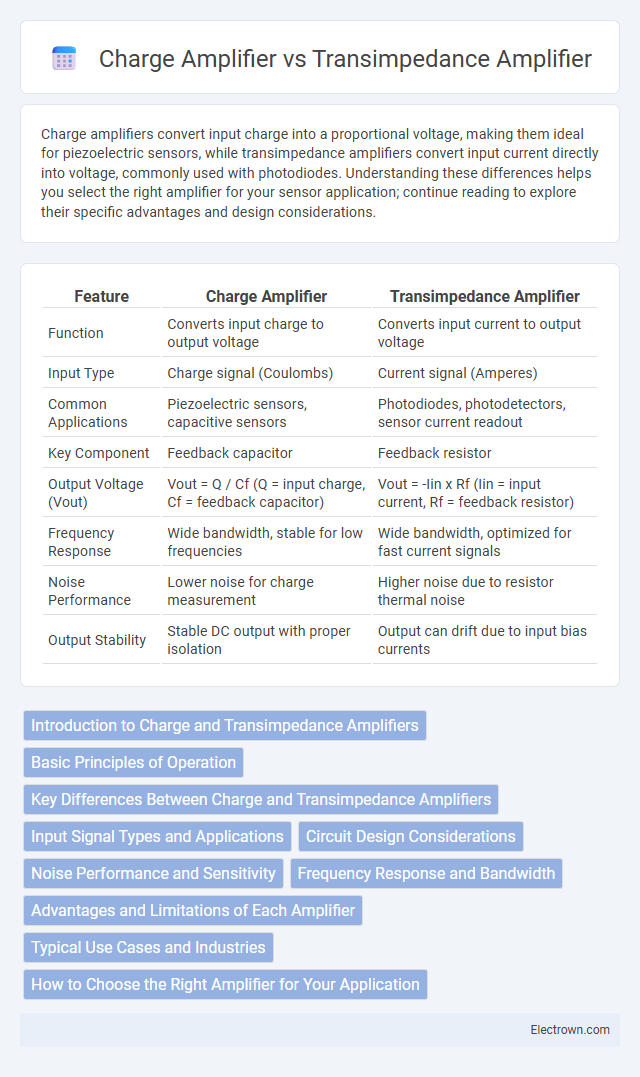Charge amplifiers convert input charge into a proportional voltage, making them ideal for piezoelectric sensors, while transimpedance amplifiers convert input current directly into voltage, commonly used with photodiodes. Understanding these differences helps you select the right amplifier for your sensor application; continue reading to explore their specific advantages and design considerations.
Table of Comparison
| Feature | Charge Amplifier | Transimpedance Amplifier |
|---|---|---|
| Function | Converts input charge to output voltage | Converts input current to output voltage |
| Input Type | Charge signal (Coulombs) | Current signal (Amperes) |
| Common Applications | Piezoelectric sensors, capacitive sensors | Photodiodes, photodetectors, sensor current readout |
| Key Component | Feedback capacitor | Feedback resistor |
| Output Voltage (Vout) | Vout = Q / Cf (Q = input charge, Cf = feedback capacitor) | Vout = -Iin x Rf (Iin = input current, Rf = feedback resistor) |
| Frequency Response | Wide bandwidth, stable for low frequencies | Wide bandwidth, optimized for fast current signals |
| Noise Performance | Lower noise for charge measurement | Higher noise due to resistor thermal noise |
| Output Stability | Stable DC output with proper isolation | Output can drift due to input bias currents |
Introduction to Charge and Transimpedance Amplifiers
Charge amplifiers convert input charge from sensors like piezoelectric transducers into a proportional voltage, offering high input impedance and stability against sensor capacitance variations. Transimpedance amplifiers transform input current, commonly from photodiodes, into voltage, emphasizing low noise and wide bandwidth for accurate current-to-voltage conversion. Understanding these fundamentals clarifies how Your choice depends on the sensor type and signal characteristics for optimal measurement performance.
Basic Principles of Operation
Charge amplifiers convert input charge into a proportional voltage by integrating the current from sensors like piezoelectric crystals, making them ideal for measuring small charges. Transimpedance amplifiers convert input current into voltage using a feedback resistor, commonly used with photodiodes for precise current-to-voltage conversion. Your choice depends on whether you need to measure charge with high stability or directly convert current for signal conditioning.
Key Differences Between Charge and Transimpedance Amplifiers
Charge amplifiers convert input charge into a proportional voltage, making them ideal for measuring charge from sensors like piezoelectric devices, while transimpedance amplifiers convert input current to voltage, commonly used for photodiode signal amplification. Charge amplifiers feature high input impedance and are less affected by input capacitance variations, whereas transimpedance amplifiers require low input impedance to maintain stability and accurate current-to-voltage conversion. The bandwidth of charge amplifiers is generally limited by feedback components, whereas transimpedance amplifiers offer higher bandwidth suitable for fast photodetection applications.
Input Signal Types and Applications
Charge amplifiers are ideal for capacitive sensors such as piezoelectric transducers, converting input charge signals into measurable voltage outputs, commonly used in vibration and dynamic pressure sensing. Transimpedance amplifiers excel with photodiodes and current-output sensors by converting low-level input currents into voltage, making them essential in optical communication and photodetection applications. Your choice depends on whether the input signal is a charge or current, as well as the specific measurement environment.
Circuit Design Considerations
Charge amplifiers require precise feedback capacitors and low-leakage input components to maintain high stability and accurate charge-to-voltage conversion, making PCB layout critical to minimize noise and parasitic capacitances. Transimpedance amplifiers emphasize optimizing feedback resistor values and bandwidth to achieve desired current-to-voltage gain while controlling noise performance and input capacitance effects. Both designs demand careful selection of low-noise operational amplifiers and thermal management to ensure signal integrity in sensitive sensor applications.
Noise Performance and Sensitivity
Charge amplifiers exhibit superior noise performance by minimizing input current noise and effectively integrating sensor capacitance, making them ideal for low-frequency, high-impedance applications. Transimpedance amplifiers offer enhanced sensitivity through direct current-to-voltage conversion with low input impedance, benefiting photodiode and high-speed sensor interfaces. Optimal selection depends on balancing noise floor requirements with bandwidth and application-specific sensitivity needs.
Frequency Response and Bandwidth
Charge amplifiers exhibit a wide frequency response ideal for low-frequency and quasi-static measurements due to their ability to convert input charge into a voltage output with minimal noise. Transimpedance amplifiers (TIAs) offer superior bandwidth performance, especially at high frequencies, by converting input current directly to voltage with low input capacitance impact, making them suitable for fast photodetector applications. Your choice depends on the need for either a broad, stable low-frequency response or high-speed measurement capabilities, with TIAs excelling in high-frequency bandwidth and charge amplifiers in maintaining signal integrity at low frequencies.
Advantages and Limitations of Each Amplifier
Charge amplifiers offer high sensitivity and low noise performance for measuring small charge signals, making them ideal for piezoelectric sensors; however, they are limited by their susceptibility to baseline drift and sensitivity to cable capacitance. Transimpedance amplifiers convert current to voltage with excellent bandwidth and stability, well-suited for photodiode applications, but they can suffer from increased noise and reduced gain at high frequencies. Each amplifier's effectiveness depends on the specific sensor type and application requirements, balancing signal integrity against operational constraints.
Typical Use Cases and Industries
Charge amplifiers are primarily used in piezoelectric sensor applications for measuring dynamic pressure, vibration, and force in industries such as aerospace, automotive, and industrial machinery. Transimpedance amplifiers excel in photodiode signal processing, optical communication, and biomedical instruments due to their ability to convert low-level currents to voltage with high precision. Both amplifier types are critical in scientific research, defense, and environmental monitoring, where accurate signal conditioning is essential.
How to Choose the Right Amplifier for Your Application
Selecting the right amplifier hinges on your sensor type and signal characteristics: charge amplifiers excel in processing capacitive sensor outputs by converting charge to voltage with high stability, making them ideal for piezoelectric applications. Transimpedance amplifiers convert input current to voltage, offering low noise and high bandwidth, optimal for photodiodes and other current-output sensors. Your choice depends on whether your application demands precise charge measurement or sensitive current-to-voltage conversion to ensure accurate and reliable signal conditioning.
charge amplifier vs transimpedance amplifier Infographic

 electrown.com
electrown.com